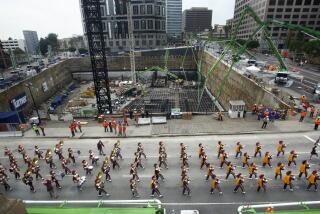Mitsubishi to Buy State’s No. 2 Cement Plant
- Share via
A Japanese mining company, part of the vast Mitsubishi group, announced Monday that it is buying California’s second-largest cement plant for $185 million in cash.
The acquisition represents the first major Japanese investment in the $4 billion U.S. cement industry, which is more than half owned by foreign companies.
Walnut Creek-based Kaiser Cement, a division of Hanson PLC in London, signed an agreement on Friday with Mitsubishi Mining & Cement to sell its Lucerne Valley plant together with distribution terminals in Long Beach and Phoenix.
Mitsubishi, headquartered in Tokyo, will pay another $10 million for cement on hand when the sale is completed about April 1, said John H. Wimberly, Kaiser’s president and chief executive.
The giant plant was enlarged in 1982 to a production capacity of 1.6 million tons annually. It accounts for 12.8% of California’s cement-making capacity, said Max D. Moore of the Portland Cement Assn., an industry trade group.
‘Industry Is Strong’
U.S. cement may be attractive to Japanese companies because the weak dollar makes U.S. assets look cheap to companies paying in yen and because demand for cement should stay strong for the foreseeable future, said Charles J. Johnson, a senior minerals economist with the East-West Center in Honolulu. “The exchange rate is good and the industry is strong. . . . It’s not an industry that is vanishing.”
Mitsubishi’s purchase is consistent with the trend toward greater foreign ownership of the U.S. cement business and U.S. mining in general, he said. Foreign ownership of U.S. cement production capacity has rocketed from about 35% at the end of 1985 to 54% last December.
Hanson bought Kaiser last March for $250 million, and has rapidly dismantled the company. In addition to the sale of the Lucerne Valley plant, Hanson has sold Kaiser cement plants in Texas and Montana plus docks in Seattle and Alaska. Still pending is a $26-million sale to Mitsubishi of Kaiser’s stake in an Indonesian cement plant, Wimberly said.
Hanson retains Kaiser’s cement distribution network on the Pacific islands of Guam and Saipan, a concrete plant and a sand and gravel mine in Texas, a crushed stone mine in Northern California, and another cement plant near San Francisco with a capacity of 1.6 million tons, he said.
The Lucerne Valley plant, which reported pre-tax profits of $14.7 million on sales of $86.8 million in 1987, is located 27 miles southeast of Victorville and 85 miles northeast of Los Angeles. The plant is there, Wimberly said, because it is near quarries of limestone--the main ingredient of cement.
Cement is manufactured by baking crushed limestone ore and certain additives in a kiln at 2,700 degrees, allowing the mixture to cool, and then stirring in gypsum. The result is a gray powder that is mixed with sand, gravel and water to make concrete for construction projects.
More to Read
Inside the business of entertainment
The Wide Shot brings you news, analysis and insights on everything from streaming wars to production — and what it all means for the future.
You may occasionally receive promotional content from the Los Angeles Times.










